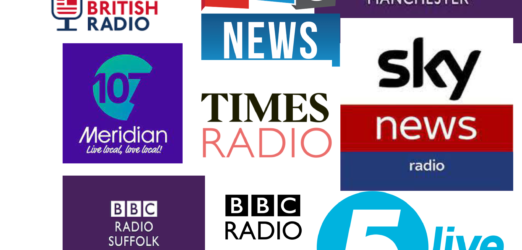In the 18 years we’ve specialised in broadcast PR, clients have never wavered in their love for radio days. Other vehicles to get on air, such as radio competitions or giveaways, have come and gone. But editorial coverage, in news bulletins and mainly day time programming, is more in demand than ever.
What do clients love about radio PR?
First of all coverage is guaranteed. For nearly every story we work on, we guarantee a minimum of 10-12 opportunities and a reach of at least a million listeners. Chances are however we exceed this with no further cost. And we’re talking quality coverage. Whilst we know some agencies will include tiny and even hospital radio in their schedules, our media relations team is primed to secure quality coverage. That means primarily national stations, followed by large, urban based regional stations.
Finding your target audience
Although broadcast is broad by name and broad by nature it is possible to focus on particular audiences. Different radio stations attract different listeners. You can adapt a story to suit listener age, social grade, gender and geographical basis. That’s why at the beginning of a radio day we ask what aspects of a campaign are going to make you most happy. For some clients it’s about reaching the biggest audiences possible, regardless of how long they get on air. Others are looking to explain key messages, so BBC or smaller commercial stations might be more appropriate as they offer longer, live interviews. It’s not a case of one size fits all. Instead, it’s about tailoring a campaign so that the outcome best fits your business objectives.
To achieve this, we adapt our press releases so they better suit different broadcasters. We also make great use of every case study and regional statistic you have, to ensure as much coverage as possible. It’s more work for you and us, but you reap the fruit of your labour, so worth it.
Radio’s great legacy
Radio is often the first place people turn to for trustworthy, reliable news. I’m not saying it’s the quickest. Yep, you can dip into social media and get it first on Twitter. But that’s not the same as seeking information from a trusted source.
We also tune in to radio to be distracted and entertained. The Covid-19 pandemic is testament to both reasons and broadcasters have reacted accordingly.
Not surprising then that radio attracts such large audiences. Typically a BBC regional station, based in a city, has a reach of 180,000. talkRADIO is heard by 400, 000 and Radio 5 Live has a weekly reach of 5.4 million, just to name a few. Radio also delivers a larger audience than other media throughout the morning.
BBC plans
The BBC’s new Director of Nations, Rhodri Talfan Davies, was recently quoted as saying that local and regional media is more important today than arguably ever before. “In the depths of Covid, “ he said, “our regional and local services have been a source of news and companionship for millions of people.”
The BBC has recently announced its plan for what it’s hailed as the organisation’s “biggest transformation in decades.” Although it has been running a programme of cutbacks for a number of years, the organisation is committing to be more local than ever.
It’s promising up to six new peak-time BBC local radio services in communities “where we know we need to do more”. Bradford, Sunderland and Wolverhampton are among the areas pin-pointed. There will also be on-demand bulletins on BBC Sounds, tailored to different regions.
Commercial radio
Commercial radio in the UK has recently gone in one of two directions, either very big or very small. Last year media giant Bauer swallowed up nearly 60 local stations. Most of them were rebranded as Greatest Hits Radio, with no opportunity for PR generated content. But in response to this a new flurry of independent online local stations have been launched. They’re in the same locations and their focus is more on talk than music. This is obviously better news for radio PR.
Read more about the revolution in commercial radio in another of our blogs here
What does this mean for broadcast PR?
In a nutshell it means the old formula of a good top line, along with solid regional interest, still has strong legs. If you want regional coverage then think local. But, you should have a really good spokesperson, ideally a celebrity, if your heart is set on coverage on any of the larger commercial stations. If you want guaranteed, quality coverage, reaching millions of people, radio is the most reliable of mediums.
For more about our radio PR days click here.



